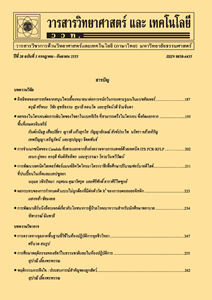การเปรียบเทียบประสิทธิภาพแผนภูมิควบคุมคุณภาพในการตรวจพบการเปลี่ยนแปลงค่าเฉลี่ยของกระบวนการ
Main Article Content
Abstract
บทคัดย่อ
งานวิจัยนี้มีวัตถุประสงค์เพื่อเปรียบเทียบประสิทธิภาพแผนภูมิควบคุมคุณภาพในการตรวจพบการเปลี่ยน แปลงค่าเฉลี่ยของกระบวนการ 4 แผนภูมิ คือ แผนภูมิควบคุมผลรวมแบบวิ่ง (RUNSUM) แผนภูมิควบคุมค่าเฉลี่ยแบบปรับน้ำหนักตอบสนองอย่างรวดเร็ว (FIR-EWMA) แผนภูมิควบคุมผลรวมสะสมชิวฮาร์ทร่วม (CS) และแผนภูมิควบคุมความแกร่งค่าเฉลี่ยเคลื่อนที่ปรับน้ำหนักแบบเอกซ์โพเนนเชียล (REWMA) เมื่อข้อมูลมีการแจกแจงแบบปกติ โดยกำหนดปัจจัยต่าง ๆ ดังนี้ ขนาดการเปลี่ยนแปลงค่าเฉลี่ยที่เปลี่ยนแปลงไปจากค่าเฉลี่ยของกระบวนการ () มีค่าตั้งแต่ 0.2, 0.4, 0.6, 0.8, 1.0, 1.2, 1.6, 2.0, 5.0 ขนาดตัวอย่าง ในแต่ละกลุ่มย่อยเท่ากับ 2, 3, 4, 5, 6, 7, 10, 14, 20, 30 และจำนวนชุดตัวอย่าง () เท่ากับ 40 ซึ่งเกณฑ์ที่ใช้ในการเปรียบ เทียบประสิทธิภาพแผนภูมิควบคุมทั้ง 4 แผนภูมิ คือ ค่าความยาววิ่งเฉลี่ย () โดยจำลองข้อมูลด้วยเทคนิคมอนติคาร์โลทำซ้ำ 1,000 ครั้ง ในแต่ละสถานการณ์ ผลการศึกษาพบว่ากรณี มีการเปลี่ยนแปลงน้อย (= 0.2) ในระดับของขนาดตัวอย่าง = 2, 3, 4 แผนภูมิควบคุม FIR-EWMA มีประสิทธิภาพในการตรวจพบการเปลี่ยนแปลงไปของค่าเฉลี่ยของกระบวนการได้ดี อย่างไรก็ตาม ในกรณี มีการเปลี่ยนแปลงมาก (> 1.6) และขนาดตัวอย่างมากกว่า 4 แผนภูมิควบคุม REWMA แผนภูมิควบคุม FIR-EWMA และแผนภูมิควบคุม RUNSUM มีประสิทธิภาพใกล้เคียงกัน นอกจากนี้พบว่าแผนภูมิควบคุม CS มีประสิทธิภาพในการตรวจพบการเปลี่ยนแปลงไปของค่าเฉลี่ยของกระบวนการต่ำที่สุดในทุกสถานการณ์ที่ศึกษา
คำสำคัญ : การแจกแจงแบบปกติ; ความยาววิ่งเฉลี่ย; แผนภูมิควบคุมผลรวมแบบวิ่ง; การเปลี่ยนแปลงไปของค่าเฉลี่ยของกระบวนการ
Abstract
The objective of this research is to compare the efficiencies of four control charts–the run sum (RUNSUM) control chart, the exponential weighted moving average control chart with fast initial response (FIR-EWMA), the combined Shewhart-CUSUM (CS) control chart and the robust exponentially weighted moving average (REWMA) control chart–when the data are normally distributed. The studied factors consist of the mean shifts () at 0.2, 0.4, 0.6, 0.8, 1.0, 1.2, 1.6, 2.0, 5.0, sample sizes which are 2, 3, 4, 5, 6, 7, 10, 14, 20, 30 and subgroup size () at 40. Furthermore, the criterion used to examine efficiency is in term of an average run length (). A simulation study is conducted by Monte Carlo technique with 1,000 repetitions. It is found that, FIR-EWMA control chart has the best efficiency for a small shift in the mean (= 0.2) and sample sizes = 2, 3, 4. However, the efficiencies of three control charts-FIR-EWMA control chart, REWMA control chart and RUNSUM control chart -seem to have no difference for > 4 and large shift in the mean (>1.6). Moreover, the CS control chart has a poor performance in detecting mean shift among the four control charts for all situations of the study.
Keywords: normal distribution; average run length; RUNSUM; mean shift


